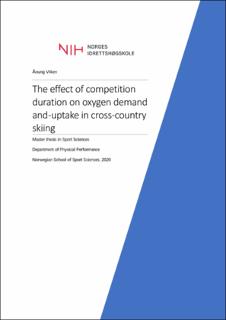| dc.description.abstract | Purpose: This study aimed to investigate changes in pacing patterns and energy system contributions in a short (~3.5 min), middle distance (~7.6 min) and long race (~15.8 min) in competitive XC skiers during roller skiing. We hypothesized that the relationship between average metabolic energy turnover (VO2dem) and race duration follows an approximately inverse curve in intermittent endurance exercise, similar to constant load endurance exercise. We additionally expected average VO2 uptake to not change with test duration.
Methods: 12 competitive XC-skiers (8 male and 4 female, VO2Max 78. ± 2,5 and 63.5 ± 3.9 mL/kg/min) raced a 1.6 km course at 3 distinct tests for 1, 2 and 4 laps (~3.5, ~7.6 and ~15.8 min) in a randomized order with 35 min breaks in-between. VO2 and GPS data was acquired to establish VO2 uptake and demand. On an additional day, the athletes completed 6 submaximal loads of 5 min and a 1000m uphill maximal effort test to establish skiing economy, VO2-Max and maximal ΣO2-deficit (MAOD). Pulmonary VO2 was measured using mixing chamber. ΣO2-def and VO2 demand was calculated from an athlete-specific model of skiing economy.
Results: During the 1, 2 and 4 laps tests, average VO2dem including tucked position was 110 ± 8 %, 101 ± 7 % and 96 ± 7 % of VO2max respectively. When excluding tucked position, corresponding VO2dem averaged 130 ± 9 %, 119 ± 9 % and 112 ± 8 % of VO2max. Both peak and average VO2dem followed an inverse relationship with test duration irrespective of whether tucked position was included or not. The average VO2 uptake was similar on all tests with 86 %, 86 % and 84 % of VO2max on the 1, 2 and 4 laps respectively.
Conclusion: We established a relationship between energy demand and test duration in XC skiing which indicates similar duration-dependent energy demand changes in highly intermittent endurance exercise modalities compared to constant load endurance exercise. | en_US |
